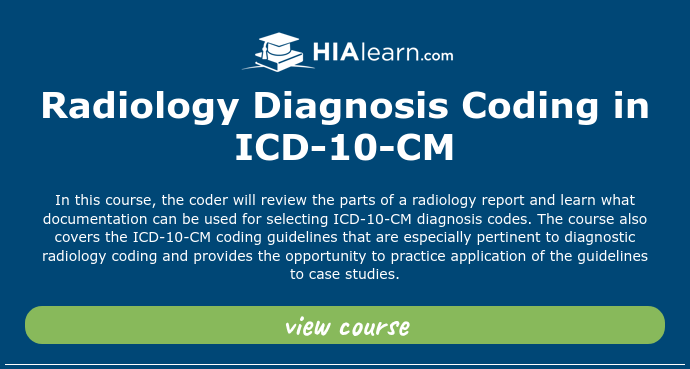
Assigning diagnosis codes for diagnostic radiological studies (e.g., x-ray, CT, MRI, ultrasound, mammogram) can be very challenging, even for experienced coders. The documentation generated for a diagnostic radiology study is different than many other medical reports because the radiologist never directly questions or examines the patient related to the reason for performance of the study. The radiologist relies on information collected by someone else to identify the patient’s chief complaint or the reason why the study was ordered. However, carefully following correct coding principles and the ICD-10-CM coding guidelines and understanding the documentation components that comprise a radiology report make it possible to assign an appropriate diagnosis code(s) to diagnostic radiological studies.
ICD-10-CM Guidelines
As with all types of diagnosis coding, applying direction in the official guidelines is key to coding that is accurate and complete. Although all the guidelines should be considered when assigning diagnosis codes for radiological studies, there are a few guidelines that, due to their pertinence, rise to the top in terms of importance for this type of coding. Key guidelines for radiology diagnosis coding include:
- Section IV Diagnostic Coding and Reporting Guidelines for Outpatient Services
- Section I.C Chapter Specific Coding Guidelines
- Section I.B General Coding Guidelines
Each of these has application when selecting diagnosis codes for radiology coding as outlined below.
Section IV.G-H
These guidelines are specific to the outpatient setting and provide direction on how to select the first listed diagnosis for outpatient encounters and when to assign codes for signs/symptoms rather than uncertain or unconfirmed diagnoses.
Section IV.K
This guideline is specific to coding of diagnostic tests such as radiology studies. This guideline confirms that coders should, in the outpatient setting, code for definitive diagnoses rather than signs/symptoms for a test that has been interpreted by a physician.
Section I.C.21.c.5
This guideline says in part,
“A screening code may be a first-listed code if the reason for the visit is specifically the screening exam.
Should a condition be discovered during the screening then the code for the condition may be assigned as an additional diagnosis.”
This guideline provides the direction relevant to selecting the primary diagnosis code for screening mammograms.
Section I.B.4-6, 18
These are general coding guidelines that direct the assignment of codes for signs/symptoms as opposed to or in conjunction with codes for definitive diagnoses. These guidelines are relevant to coding for diagnostic radiological studies as the reason for ordering the exam is often investigation of signs/symptoms and the coder must know how to determine the appropriate diagnosis to code dependent on what is documented in the radiology report.
Documentation Components of a Radiology Study
Familiarity with the purpose of each documentation component of a radiology study helps the coder understand from which parts of the documentation diagnosis codes can or cannot be assigned.
Physician Order
In addition to the specific type of radiology procedure the physician has ordered to be performed, the physician order includes the reason why the study has been ordered, which is referred to as the reason for exam.
Selection of the primary diagnosis for an account is determined by comparing the reason for exam in the physician order to information from the physician interpretation of the study.
Parts of a Radiology Report
Demographic/Patient Information
The coder will use this information to ensure codes are being added to the correct patient account. It may also be helpful if there is a need to confirm patient gender for diagnosis code selection such as with breast cancer.
Exam
This part of the report is used for selecting the correct procedure code. It has little impact on diagnosis code assignment other than perhaps indicating anatomic site and/or laterality of a diagnosis.
Indication
The indication provides a description of the clinical reason the study is being ordered. The indication communicates to the radiologist what the study is intended to evaluate, confirm or rule-out.
Technique
The technique section of a radiology report documents how a study was performed and the methods by which the study was conducted. This information may impact procedure code assignment but has little to no influence on selection of the correct diagnosis code.
Comparison
This section documents information about previous radiology studies available for comparison with the current study. This information provides context that helps the radiologist interpret the findings of the current study. The coder does NOT code from this section because it does not represent current findings or the radiologist’s interpretation of current findings.
Findings/Results (Body of the Report)
The findings section is where the radiologist documents what they observed when looking at the images generated by the study. Coders do NOT pick up diagnoses from this section of the report because the findings are not an interpretation of the observations. However, coders can use the findings section of the report to assign a code for a condition to a greater degree of specificity such specification of the type and location of a fracture or the location of a cerebral vascular accident.
Interpretation
The last part of a radiology report is the interpretation. This is where; after reviewing and considering all the findings from the study, the radiologist documents their professional opinion of what the study reveals. Because coders can code from this part of the report, the information documented in the interpretation determines whether selection of the primary diagnosis is based on the indication for the study or something discovered by the radiologist when reviewing the images produced by the study.
Although assignment of diagnosis codes for a radiology report can be demanding, using the concepts presented will sharpen documentation review skills and understanding of guideline application and build confidence in tackling difficult coding tasks.
For expanded instruction in diagnostic radiology coding, including case studies and self-assessments, see our HIALearn course Diagnostic Radiology Coding in ICD-10-CM.
References
- ICD-10-CM Official Guidelines for Coding and Reporting
For the past 30 years, HIA has been the leading provider of compliance audits, coding support services and clinical documentation audit services for hospitals, ambulatory surgery centers, physician groups and other healthcare entities. HIA offers PRN support as well as total outsource support.
The information contained in this coding advice is valid at the time of posting. Viewers are encouraged to research subsequent official guidance in the areas associated with the topic as they can change rapidly.
Subscribe to our Newsletter
Recent Blogs
Related blogs from Industry News , Medical Coding Tips
Interventions for endovascular revascularizat...
The 2026 updates to CPT and the Hospital Outp...
Accurate diagnosis coding relies on recognizi...
Halloween brings fun, fright—and a rise in em...
Subscribe
to our Newsletter
Weekly medical coding tips and coding education delivered directly to your inbox.


.png)


